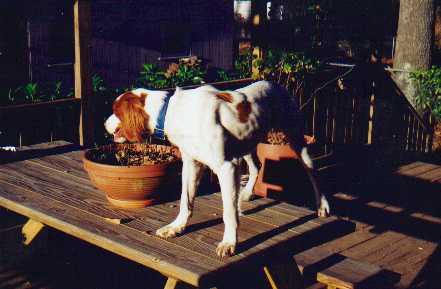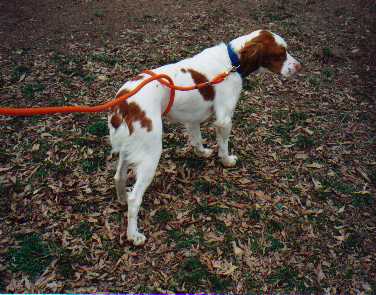Bird Dogs...
Quail...
Resources...
Library...
Dog Training Collars
Tri-Tronics
SportDog
Dogtra
Innotek
A Diamond in the Rough
Part III: Basic Obedience
As is the case with people, bird dogs must crawl before they walk and walk before they run. In more literal terms, they must be socialized before they can be trained, and they must have some basic training before they can begin work with live birds. In Part II, we covered some of the early socialization issues with JJ, a rescued Brittany who spent the first year and a half of his life chained up in the woods. This article will cover his transition from being socialized to beginning basic obedience work.
JJ's situation with regard to obedience training was much like that of a puppy: he had been socialized and had never been exposed to any sort of training. He did, however, have an advantage over a true pup in that his attention span was somewhat greater. The primary impediment to training was JJ's extreme sensitivity, which often bordered on cowering. Correction, reinforcement and discipline through traditional methods were not an option. All reinforcement would be done through positive methods, namely by praising a suitable response to a command. Unsuitable responses would be ignored rather than reprimanded. A time-consuming process to say the least, but realistically the only available option.
Sit
As of late, there is some controversy over whether a pointing dog should be taught to sit before he is taught to point. Opponents maintain that teaching sit prior to teaching other commands leads a dog to want to sit while on point. This runs contrary to what many of the recognized masters such as Wolters, Wehle, Tarrant and others preach, and having acknowledged the opposition, I will proceed in the more traditional manner. Sit seemed like a good place to begin JJ's obedience training. It is a useful command around the house and yard; it does not involve any specialized apparatus; it allows close physical contact with the dog.
It took about a week to get him to sit on command. At first, his response time was rather slow. It was as if he had to think about what I said, and even when he started to sit, he did it slowly, just to make sure he was doing what I wanted. I used the traditional "one hand pulling up on the collar and the other hand pushing down on his back end" method. He showed a lot of resistance to the rear-end pushing at first. He never tried to run away, but he made it obvious that he would oppose my efforts by standing staunchly. Slowly, he began to give in, and within a few days he offered less resistance to the pushing.
Stay was not taught separately but instead became a part of the sit command. This was reinforced through a pure reward: JJ was allowed to lick the dinner plate after I finished eating supper. Before he was allowed to clean the plate, however, he was told to sit and was made to wait for varying periods of time before being released.
Come
Training JJ to come was more of an informal task- I took advantage of the times when he was already moving toward me and repeated the command. When he arrived, I praised him. Eventually, I had to try the command when he was not moving toward me. Naturally there were times when he did not comply, and in those instances I simply disappeared from view. This was a more gradual process than the "don't give a command you can't enforce" method, but I now have a dog that comes when called 98% of the time, and he comes because he wants to, not because he's been force-trained through pressure from a rope.
Heel
A makeshift harness sped up JJ's acceptance of this command (see picture below). I introduced this command with only a lead attached to his collar, but he showed a relentless tendency to pull hard at the lead. Fashioning the lead into a harness, I ran the loose end behind my back and held it with my opposite hand. I used the near hand as a lever to apply rearward pressure on the harness when I wanted him to stop. The rest of the process was textbook: command "heel" and start walking; apply rearward pressure to the harness when I stop. Early on, I began making 180° turns, which he followed with very little resistance. Like most dogs, he had a strong tendency to continue walking when I stopped, but once stopped, he was content to wait beside me until I began walking again.
After several weeks on the makeshift harness, I changed over to a slip lead. JJ adjusted instantly and no longer pulls on the lead while heeling.

|
Whoa
At the time of writing, JJ's whoa training is only partially complete. I've used my version of a whoa table, which serves double duty as a picnic table when I'm not training the dogs (see picture). He'll stand staunchly on the table until I release him, but has not made the transition to whoa on a leash or in the yard.
Steady to wing
This one was somewhat of an accident. Normally, I wouldn't work on steadiness until a dog had been exposed to game birds. If you'll remember, the trait that got me started on this project was JJ's extreme interest in anything that flew. I never considered that trait to be a drawback until I started taking him on walks through the neighborhood.
Walking on the leash came fairly naturally. He pulled at first, but seemed pretty relaxed overall. Because of his neophobic nature, I was concerned that all of the new sights, sounds and smells he would encounter on a walk through the neighborhood would overwhelm him, reducing him to a quivering bundle of fur or sending him into a frenzy. Much to my surprise and relief, he was completely at ease. Very little correction was needed, the exception being when he spotted birds or squirrels.
Birds, butterflies, bees, moths, and squirrels are the only creatures I have found that do not intimidate JJ. He pursues them like a cop after a criminal. On walks, JJ would frequently spot songbirds before I would, and would alert me to their presence by nearly pulling my arm out of its socket. Sidestepping protocol out of necessity (I need my arm), I successfully taught JJ to stop at the sight of a moving bird. This was done during the course of a two-mile walk and without any special equipment.
 |
| The makeshift harness |
Early in the walk, I fashioned a makeshift harness out of JJ's leash by running it between his shoulder blades, down the left side of his rib cage, underneath his belly, up the right side of his rib cage, underneath the leash already running down his back, and then straight back to my hand (see picture). The effect of this harness is an increase in pressure around his waist, not his neck, when he pulls on the leash. When he lunged at birds, I stood still and held the leash steady.
By the end of the walk, he stopped dead in his tracks when he spotted a bird. I'm not exactly certain why he learned this in less than thirty minutes, yet took more than a week to learn to sit. Possibly he's learning how to learn, and the process shortens with every new command. Possibly there are some genetics at work that I am unaware of.
Personality
JJ's personality is beginning to bloom through no direct efforts on my part. Without warning, he will enter a room wagging his tail, bouncing around, and uttering playful growls and whines. He regularly seeks affection by approaching me and rubbing his nose on my hand or my leg and it is very common to find him sleeping at my feet. This transition from merely accepting affection to seeking it is another positive step in his socialization.
He's become much more tolerant of regular visitors to my house, and has even warmed to a few of them. He does have a territorial nature, and barks loudly at unfamiliar faces. None of his behavior has ever been aggressive beyond the barking, and in fact, he often wags his tail while he's barking. When he is taken into someone else's home, he does not bark at the occupants, and rarely barks at other people and dogs while walking in the neighborhood.
Current Status
In summary, JJ now sits, stays, and comes reliably. He heels satisfactorily on lead, but has not been heeled off-lead yet. He will hold to the command "whoa" on a bench, but has not been whoaed off-bench. He has shown the ability to hold steady to wing. These fundamentals of obedience should provide a good launch pad for his initial bird work.
In the coming months, I intend to solidify the basic obedience commands and introduce JJ to live game birds. Because he has not been heeled and whoaed off-lead yet, his exposure to game birds will be from the end of a check cord with a makeshift harness. To my knowledge, he has never been exposed to game scent and his reaction will be the turning point in this experiment.
At this stage, JJ would make a fair pet for most people. With a little finishing on the basic obedience, he would qualify as a very good pet. If the remainder of this project does not pan out due to poor scenting ability, difficulty overcoming gun shyness, or some other factor, I will still consider the effort worthwhile. JJ is a fine companion and the time spent with him has involved no frustration and a lot of reward.
Diamond in the Rough series
 Windows users press "CTRL+P" to print this page
Windows users press "CTRL+P" to print this page  Mac users press "Apple/Loop+P" to print this page
Mac users press "Apple/Loop+P" to print this page